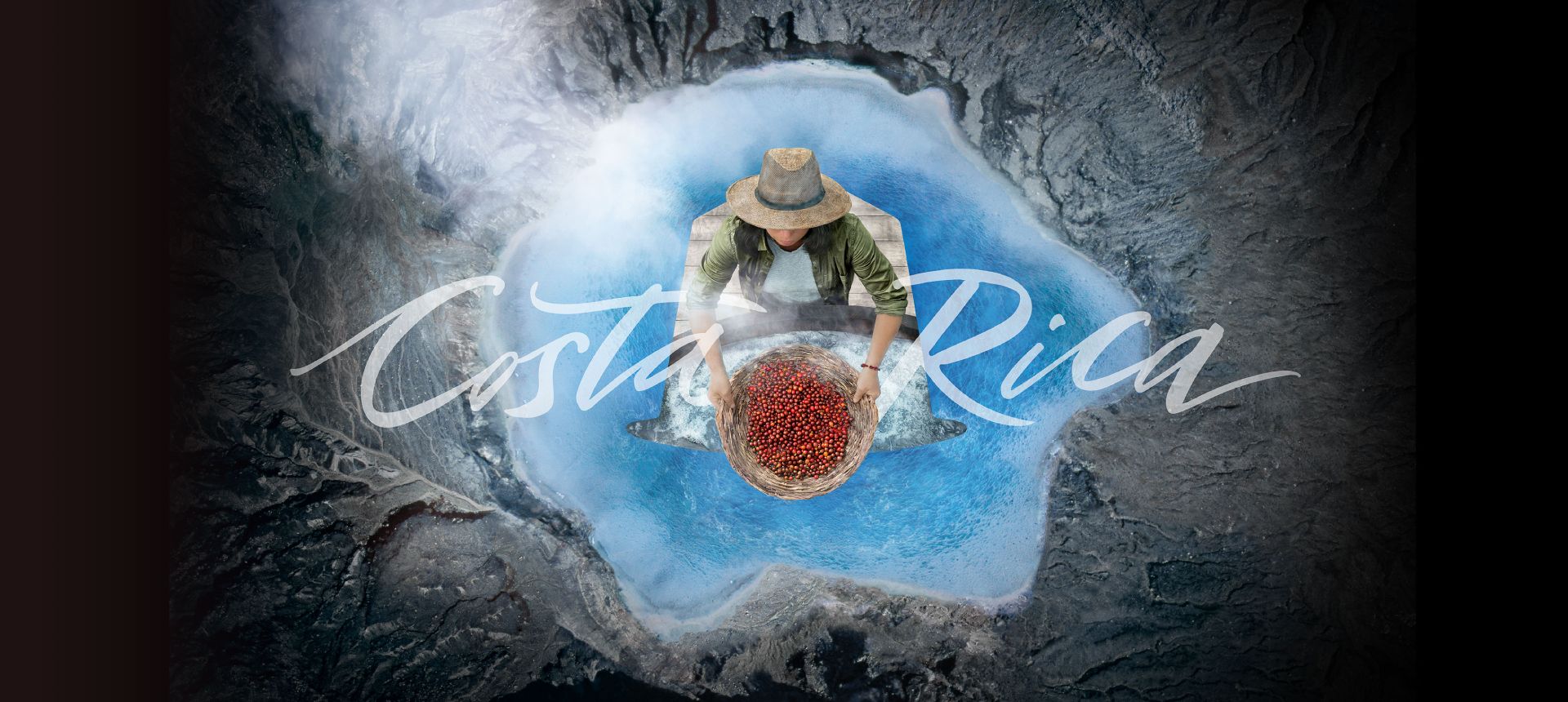Header
Purchase $75 of coffee to receive a welcome gift. First coffee order only*

In amongst Costa Rica's tropical forests, high hills and majestic volcanic landscapes, some of the world's finest coffee beans are grown. Where lush green banana plants intertwine with vibrant red coffee cherries and where bubbling hot springs simmer on the surface. This is where our coffee farmers use all that the land has to offer to create a distinct Costa Rican coffee .
What does Costa Rican coffee taste like?
The region where we source our beans produces coffee that has malty notes and develops cocoa flavours once roasted.
How is our Costa Rican coffee grown and harvested?
- High altitude locations (1,600 metres above sea level)
- Mineral rich volcanic soils
- Heavy rainfall
- Ample sunshine
- Rare fermentation process
Many Costa Rican farms are nestled high among beautiful hills and mountains at altitudes of up to 1,600 metres above sea level. In these regions, the sun shines, just the right amount, and rain is plentiful with some areas experiencing as much as 3,000 millimetres a year. The combination of glorious sunshine, heavy annual rain, and mineral-rich, volcanic soils mean that coffee grows very happily here.
Once the beans are perfectly ripened, they are hand-picked by our coffee experts. Only the finest red ripe cherries are selected.
Costa Rica: The home of an extremely rare fermentation process
Our goal is to discover delicious, unique, outstanding coffee from across the world. Every so often, we find something new and exciting, a technique that pushes boundaries and broadens our understanding of coffee craftsmanship.
High in Costa Rica's mountains, we discovered an extremely rare process, where a local farmer used hot rainforest spring water to ferment the coffee beans. 'The Hot Springs Technique' is a one-of-a-kind fermentation process that is patented by one Costa Rican farmer - so you won't find it anywhere else.
Crafted deep in the Costa Rican rainforests, among the volcanoes, hills and valleys, in one of the oldest communities in Costa Rica, Orosi's mineral hot spring. The scarcity of this coffee means that this limited-edition coffee only appears when the timing is just right.
Costa Rican Coffee Farming: Sustainability at heart
We believe that a great cup of coffee can deliver an extraordinary experience but can also create value for our communities and environment. In 2003, we partnered with the Rainforest Alliance to create the Nespresso AAA Sustainable Quality™ Program. This program combines coffee expertise with social and environmental sustainability.
We work together to produce exceptional coffee, to implement best farming practices and ensure the future and welfare of our farmers, their local communities, and our environment.
The program started out with around 300 farmer members but has since grown to more than 70,000 members from 12 countries across the world. Each member has the same goal: to create sustainable quality.
In Costa Rica, our farmers are on a journey of continuous improvement. Our sustainable practices honour ancient traditions of the land while ensuring the future of our Costa Rican coffee. Local producers have access to:
- Farmer training
- Onsite assistance from our local agronomists
- Financial, and technical support to continuously improve quality, sustainability, and productivity
Today we source 80% of our permanent coffees from the Nespresso AAA Sustainable Quality™ Program and more than 40% of all our coffee comes from farms that have achieved Rainforest Alliance certification. Our unique approach to quality coffee helps improve the livelihood of coffee farmers and the world that we live in.
Costa Rican Coffee: Our Central American blends
Vertuo Capsules
High in Costa Rica's mountains, only a small selection of Arabica coffee beans is soaked in rainforest hot spring waters. Costa Rica contains this scarce coffee whose rare process highlights the malty sweet cereal character of this craftsman's coffee.
This full-bodied and creamy coffee is a delicious blend of Arabica and Robusta coffee. Costa Rican Arabica is blended with South American Arabicas and Brazillian Robusta to balance out the full body with its soft cereal notes.
This dense and wild Arabica coffee has a powerful taste. This double long espresso is built on a blend of Arabica coffees from Central and South America. Some are washed processed - others dry processed.
Costa Rican coffee and South American Arabicas combine with Arabica beans from the mountainous Cundinamarca region to bring sweet and cereal notes together in one delicious blend.
Original Capsules
Mild and delicately toasted coffee made up of pure Arabicas. The heart of Cosi is a high-grown Arabica coffee from Costa Rica's mountains. This is combined with a blend of the finest East African, Central and South American Arabicas to create a delicate and balanced marriage of lightly toasted cereal and fruity notes.
Discover our full range of coffee blends
Costa Rican coffee recipes
Looking for some recipe inspiration? Here are a couple of our favourite ways to enjoy our Costa Rican coffee
Iced Latino Coffee Latte

Enjoy the taste of Costa Rica in this cool, classy and richly flavourful drink. Put some latin in your latte.
Ingredients:
- Nespresso Costa Rican coffee blend of choice
- 2 cl / 0.7 oz of vanilla syrup
- 100 ml / 3.4 oz of milk
- Crushed ice to taste
Method:
- Pour the vanilla syrup in a large glass
- Fill the glass with ¾ of crushed ice
- Pour the coffee on top
- Froth Milk
- Add some cold milk in the glass and some milk froth
Iced Lungo

Smooth, sweet and refreshing, it's basically a coffee, but cold.
Same taste, none of the heat.
Ingredients:
- 90g of ice
- 4 g of white sugar
- One capsule of Cosi by Nespresso
- 100ml of cold water
Method:
- Pour water into a jug and add sugar (optional)
- Add the ice
- Brew your espresso coffee and pour into your jug
- Serve the preparation in a glass
Ready to get inspired?
If you liked this article, please share:
